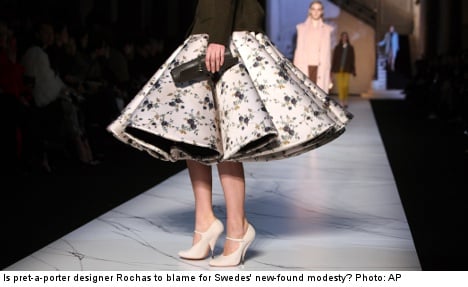A brief walk around Stockholm’s shopping districts and stylish quarters on a hot summer’s afternoon revealed a surprising lack of skin. Granted there were not many people around (something to do with queuing for tickets to see some curly-haired popstar at Allsång på Skansen that evening).
Maybe this was a one-off. I do know from my short time here that if Swedes are in the mood for sunbathing, in the park or indeed on any patch of grass big enough, the clothes come off and it’s bikinis ’til sundown.
Yet even in 25C plus heat, Stockholmers appeared to be doing summer wear rather conservatively.
IN PICTURES: See what Stockholmers had to say about the amount of skin on show in Sweden
And we’d forgive Swedes for wanting to embrace every flicker of sunshine summer can bring and bare all; after all with such long, cold, dark winters, who wouldn’t want to shed everything but the essentials and soak up some rays. As a Brit, I know the feeling.
And yet, Stockholm’s women in particular seem to be on-board with the less-is-more mind-set when it comes to summer style. Perhaps they are taking note of fashion’s rather restrained outlook on matters of the flesh this and next season.
Despite Rochas, Balenciaga, Miu Miu, and Philosophy di Alberta Ferretti all showing crop-tops for spring/summer 2013, when worn with full A-line skirts or carrot-top trousers, these teeny tops actually look rather demure.
Balance – something you learn as you get past teenage status into adulthood – a little is always more alluring than a lot. Sweden’s designer du jour, Acne replicated this in their spring/summer collection in ruffled off-shoulder tops and fragments of skin shown in blink-and-you’ll-miss-it split skirts.
At the moment, showing just a few teeny snippets of skin or only a weeny slither of midriff is not only alluring but on trend. Something Stockholm’s women seem happy with in particular, even if their younger counterparts, those pesky, body-confident teenage girls are only too happy to spend their summer days parading their bottoms in cheeky short shorts.
The trend for gossamer fabrics that play peek-a-boo with wandering eyes, a major trend for 2013, is doing its work well on Stockholm’s streets, teasing and enticing just the right side of risqué.
Does this mark a new attitude to summer skin? Do Swedes just feel more comfortable showing but a little décolletage, a slither of midriff, an ankle perhaps?
Stockholm’s women at least appear to be embracing a more grown-up attitude to showing some skin. Will the rest of Sweden’s female population keep up with the cover up whilst transitioning into autumn’s wares?
Keep your eyes peeled.
Victoria Hussey
Victoria on Twitter here




 Please whitelist us to continue reading.
Please whitelist us to continue reading.
Member comments